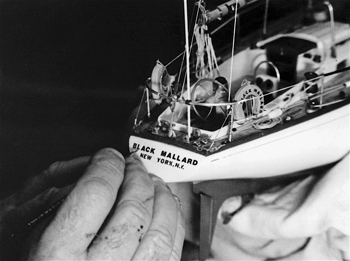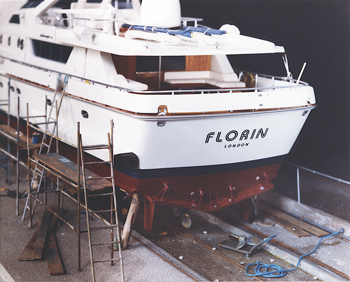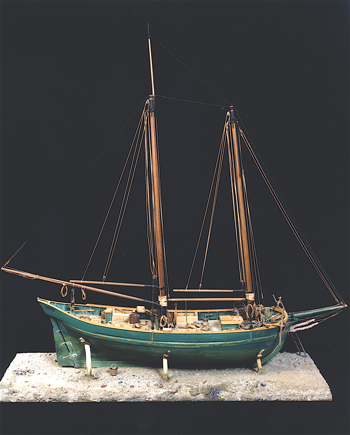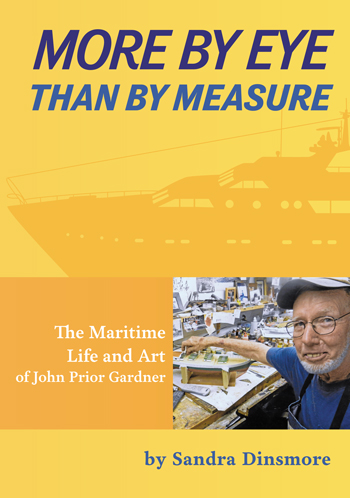A Life Immersed in the Waterfront
by J. Gardner

John Gardner lettering the transom of a yacht model. All parts of his models are uniformly miniaturized to scale. Pulleys, the wheel, cleats, ropes and rails are equally scaled to one another.
MORE BY EYE THAN BY MEASURE
By Sandra Dinsmore
Penobscot Books 2019
207-367-2200
138 pages $22.95
Building ship models has a long history in America. It was common in the ancient world with the Greeks, Phoenicians and Egyptians the most prolific. Those that have come down to us over the centuries are likely the examples that demonstrate a builders skill in building representative ships of the day.

Model of the Italian built motor yacht Florian. John flew to Antibes, France, where he spent twelve days living aboard the yacht, getting a sense of the vessel and taking measurements and photographs.
In More by Eye Than By Measure, Sandra Dinsmore tells the story of a Maine master of this ancient craft. The book tells the story of the life long study, practice and development that has resulted in some of the finest examples of modern ship model building. The book is also about the life of that ship model builder, John Gardner, who Dinsmore has know for nearly 30 years.
This was by no means a hobby for Gardner. He was born in Castine, Maine as had family members been since the 1700s. Castine has been a shipping port of historic importance, located as it is at the mouth of Maine’s largest river, the Penobscot. His father was a captain licensed to sail ships of any size, any where. When Gardner was nine, the family moved to coastal New York. John grew up and worked on the waterfront. He studied art at the Art Students League in Manhattan. This visual training would manifest itself in the ship model building that became his life’s work.

The model of the Liberty, an imaginary pinky schooner. Gardner’s models are to uniform and accurate scale and the equipment on a period vessel is historically correct. This early 1800s vessel has the pulleys in use at the time and they would be operational at this scale.
The waterfront, serving as it does as the interface between the world at sea and the land, has been populated by specialized marine businesses and culture. Marine skills, trades, knowledge, experience and language are the assets of its population. Gardner was conscious of this and reveled in it.
Gardner said, “The waterfront was rich with stories and color and people. Now it is as active as the cemetary on top of the hill in Castine. It was fun living in a subculture like that,working wirh these guys. I had occasion to work with all these ethnic groups. They all had their charm, their own way of doing things, but the Italians were by far the most intrigueing. They have intrigue, they have drama; they love to to hold vendettas against guys forever. They have great use of language – they can destroy language in a beautiful way. The Brooklyn Italian guys were beautiful-like Robert Di Nero in Raging Bull.”
One of Gardner’s ship models seen on a display case at scale is obviously a model. Gardner set some models in a diorama surrounded by elements of the waterfront- the beach, a wharf, marine railway or construction scaffolding. When photographed with the diorama out to the edge of the image these ships can become uncannily optically real. Words like accurate, precision, detailed, etc. have been used to describe his work. But authenticity describes what is happening when a viewer of a photograph of one of Gardner’s ship models cannot be sure if it is a real vessel or a model.

Dinsmore opens Chapter 12 writing, “In October 2002, John called to say hr’d decided to mbuild the derelict schooners Hesprt and Luther B. Little. He had to do yuears of planning-of talking to prople who’d taken photographs, measurements of the vessels of combing museum archives amnd scouring books fr information that would applyb to them.after building the models in his mindand dreaming about building them-despite the lack of a backer or a commission, thwe time had come, and John was ready.”
“He spent the next eight months bringing his plan to fruition.” Not a hobby.
Sandra Dinsmore has worked with antiquities and has been a journalist for many years. Her writing has been published several Maine publications including the Fishermen’s Voice. This is Dinsmore’s first book. She has let her long-time friend tell his story. The story of his life at the edge of the sea and the story of how he immersed himself in this ancient art. His models will be a window into our maritime world for future generations.
